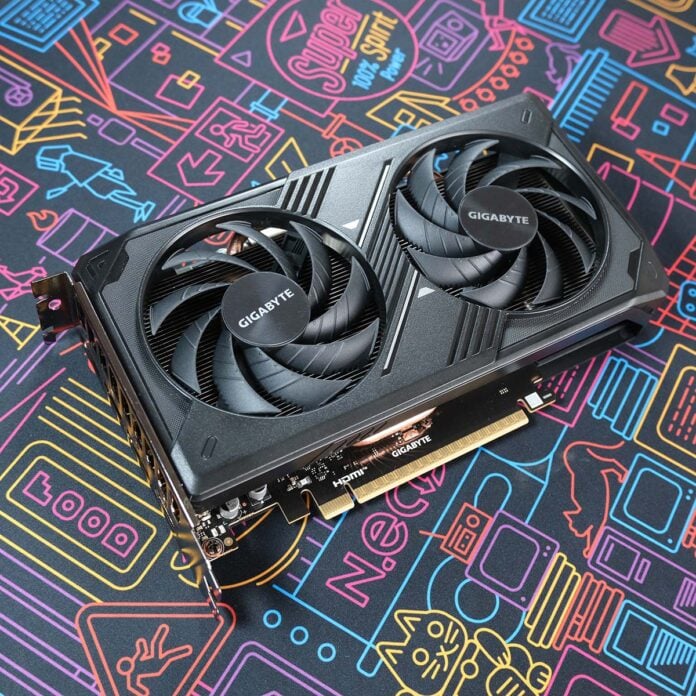The budget graphics card market hasn’t received as much love as it should in recent years, but Nvidia could provide some cause for celebration with its most affordable Blackwell GPU to date: GeForce RTX 5050. While there is merit to Team Green’s offering, comparison can prove the thief of joy for this particular pixel pusher.
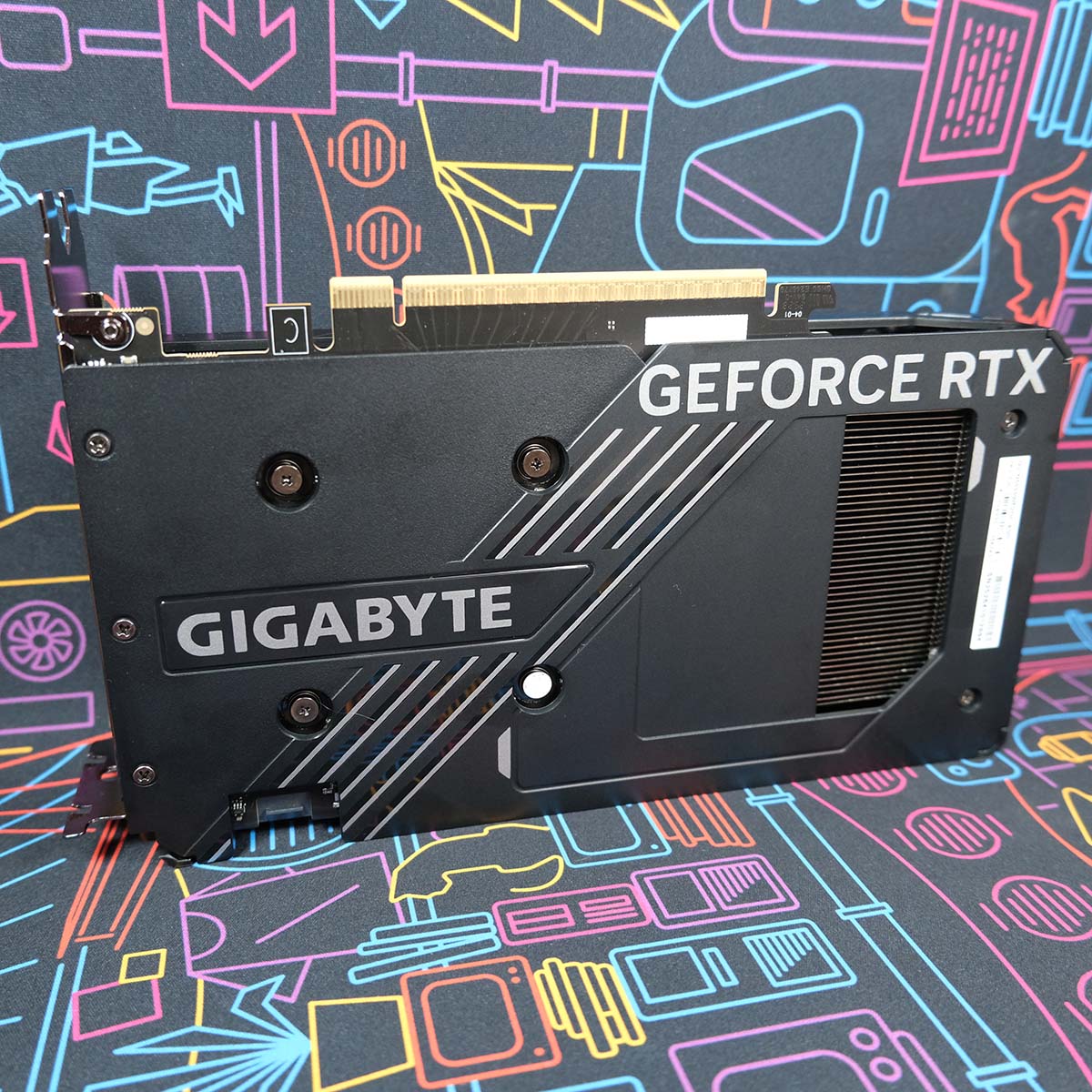

Gigabyte GeForce RTX 5050 Windforce OC
£220 / $250
Pros
- Solid FHD performance
- DLSS 4 support
- Low power consumption
- Affordable price
Cons
- Arc B580 is better value at MSRP
- Only 8GB of VRAM
- MFG usefulness is situational
Club386 may earn an affiliate commission when you purchase products through links on our site.
How we test and review products.
Arriving on store shelves with a £220 / $250 price tag, RTX 5050 marks the cheapest graphics card Nvidia has offered since RTX 3050 in 2022. Fast forward to today and there’s added importance to this crucial segment, as new competitors such as the Intel Arc B580 have arrived on the scene rocking the same MSRP.
Specifications
Distilling a cutting-edge architecture to this end of the market typically requires a lean slice of silicon. RTX 5050 marks the debut of GB207, the smallest GPU of the RTX 50 Series. While this die makes the graphics card unique among the rest of the Blackwell family, it’s not the only distinct difference.
The GPU packs in a modest 16.9bn transistors across its petite 149mm² die, providing enough room for 2,650 CUDA cores, 20 RT, and 80 Tensor, all of the latest generation. Nvidia doesn’t make any cuts to this full-fat implementation, so while there’s no room for a Ti or Super variant later down the line, there is scope to trim down and create an even cheaper OEM variant.
| RTX 5050 | |
|---|---|
| Released | Jul 2025 |
| Codename | Blackwell |
| GPU | GB207 |
| Process | TSMC N4 (4nm) |
| Transistors | 16.9bn |
| Die size | 149mm² |
| CUDA cores | 2,560 |
| Boost clock | 2,572MHz |
| FP32 Boost TFLOPS | 13.2 |
| SM count | 20 of 20 |
| RT cores | 20 (4th Gen) |
| RT TFLOPS | 40 |
| Tensor cores | 80 (5th Gen) |
| ROPs | 32 |
| Memory | 8GB |
| Memory type | GDDR6 |
| Mem. clock | 20Gb/s |
| Mem. interface | 128-bits (PCIe 5.0 x8) |
| Mem. bandwidth | 320GB/s |
| Board power | 130W |
| Launch MSRP | $250 |
Reference boost clock speeds are a match for RTX 5060 Ti at 2.57GHz, helping to bolster the power of its relatively small collection of cores. Such credentials enable peak FP32 compute of 13.2TFLOPS, just shy of Arc B580 performance (13.7TFLOPS). Factory overclocks will naturally push this value higher but they won’t quite be enough to plug this admittedly small gap.
In terms of memory, RTX 5050 notably sports GDDR6 modules that are slower than their GDDR7 counterparts, running at 20Gb/s compared to RTX 50 Series’ established floor of 28Gb/s. However, at this end of the market, their speed isn’t cause for alarm as AMD’s RX 9060 and 9070 cards demonstrate using the same chips.
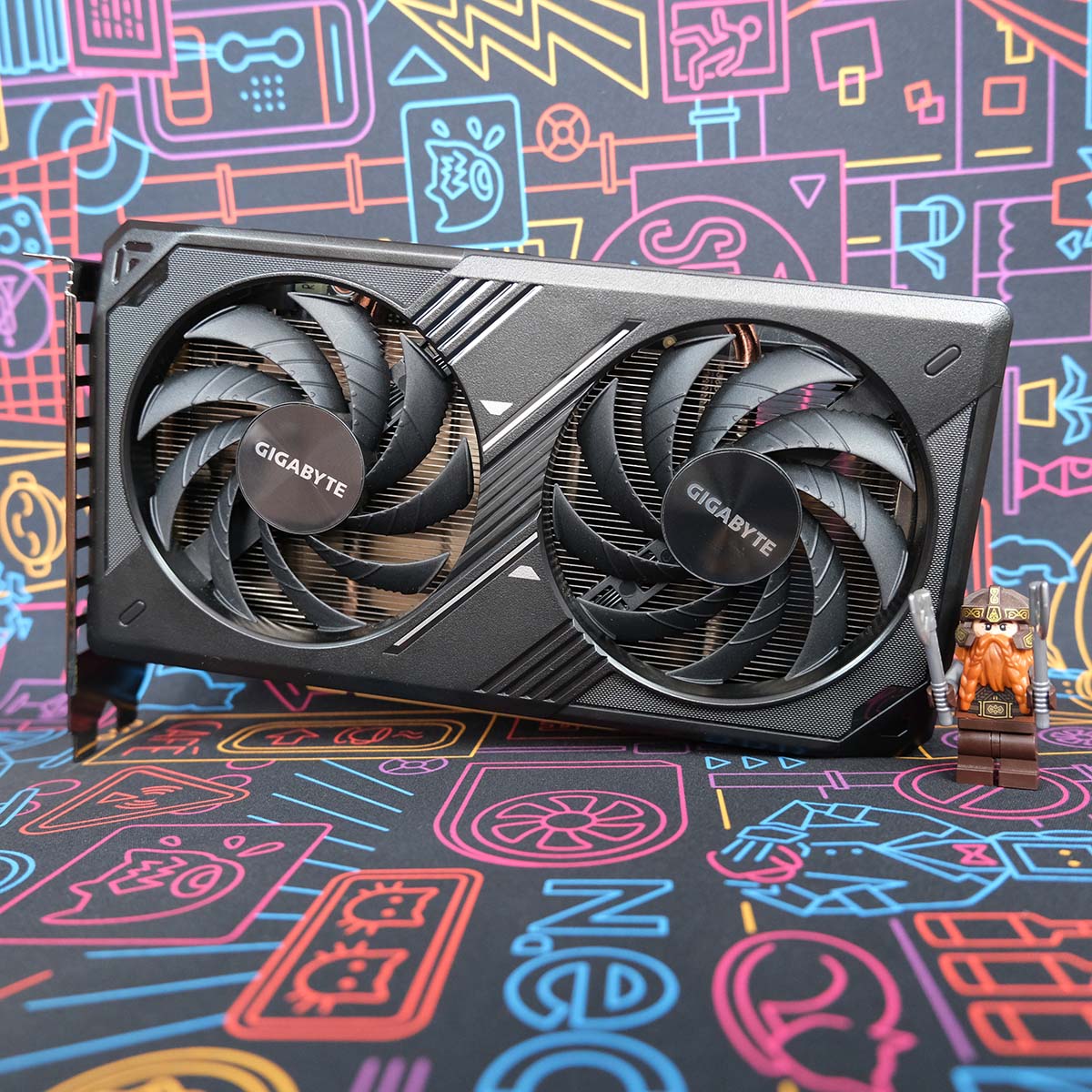
Nvidia expectedly outfits RTX 5050 with 8GB of VRAM via a 128-bit bus. This capacity has been a sticking point further up the RTX 50 Series ladder, but is more appropriate on a $250 card. Then again, it doesn’t go down easy when Arc B580 offers 12GB of the stuff at the same price.
Finally, RTX 5050 arrives on the scene with 130W at its back, mirroring the last card to grace the 50 class, RTX 3050. Nvidia recommends pairing the card with a 550W power supply, with most models requiring a single PCIe 8-pin plug.
| RTX 5050 8GB | RTX 3050 8GB | |
|---|---|---|
| Released | Jul 2025 | Jan 2022 |
| Codename | Blackwell | Ampere |
| GPU | GB207 | GA106 |
| Process | TSMC N4 (4nm) | Samsung 8nm |
| Transistors | 16.9bn | 12.0bn |
| Die size | 149mm² | 276mm² |
| CUDA cores | 2,560 | 2,560 |
| Boost clock | 2,572MHz | 1,777MHz |
| FP32 Boost TFLOPS | 13.2 | 9.10 |
| SM count | 20 of 20 | 20 of 30 |
| RT cores | 20 (4th Gen) | 20 (2nd Gen) |
| RT TFLOPS | 40 | 18 |
| Tensor cores | 80 (5th Gen) | 80 (3rd Gen) |
| ROPs | 32 | 32 |
| Memory | 8GB | 8GB |
| Memory type | GDDR6 | GDDR6 |
| Mem. clock | 20Gb/s | 14Gb/s |
| Mem. interface | 128-bits (PCIe 5.0 x8) | 128-bits (PCIe 4.0 x8) |
| Mem. bandwidth | 320GB/s | 224GB/s |
| Board power | 130W | 130W |
| Launch MSRP | $250 | $250 |
Examining RTX 5050 through a generational lens reveals some curious parallels with RTX 3050 8GB. For instance, each card shares the same number of CUDA, RT, and Tensor cores. Architectural differences naturally create invisible chasms of performance between the two, with higher clock speeds on the newer model further widening any gaps.
Comparing the number of transistors and their density helps highlight just how more advanced GB207 is to GA106. Despite being just over half the size of the older die, it crams in a far greater amount of transistors to the tune of 41%. What a difference four nanometres make.
Design
Nvidia isn’t giving RTX 5050 the Founders Edition treatment, with RTX 5070 remaining the last graphics card to receive that blessing. Once again it’s up to board partners to provide stock to market.
For this review, I’m taking a look at Gigabyte GeForce RTX 5050 Windforce OC. This is the brand’s baseline model for the graphics card, but a more premium Gaming OC variant with additional features is also available.
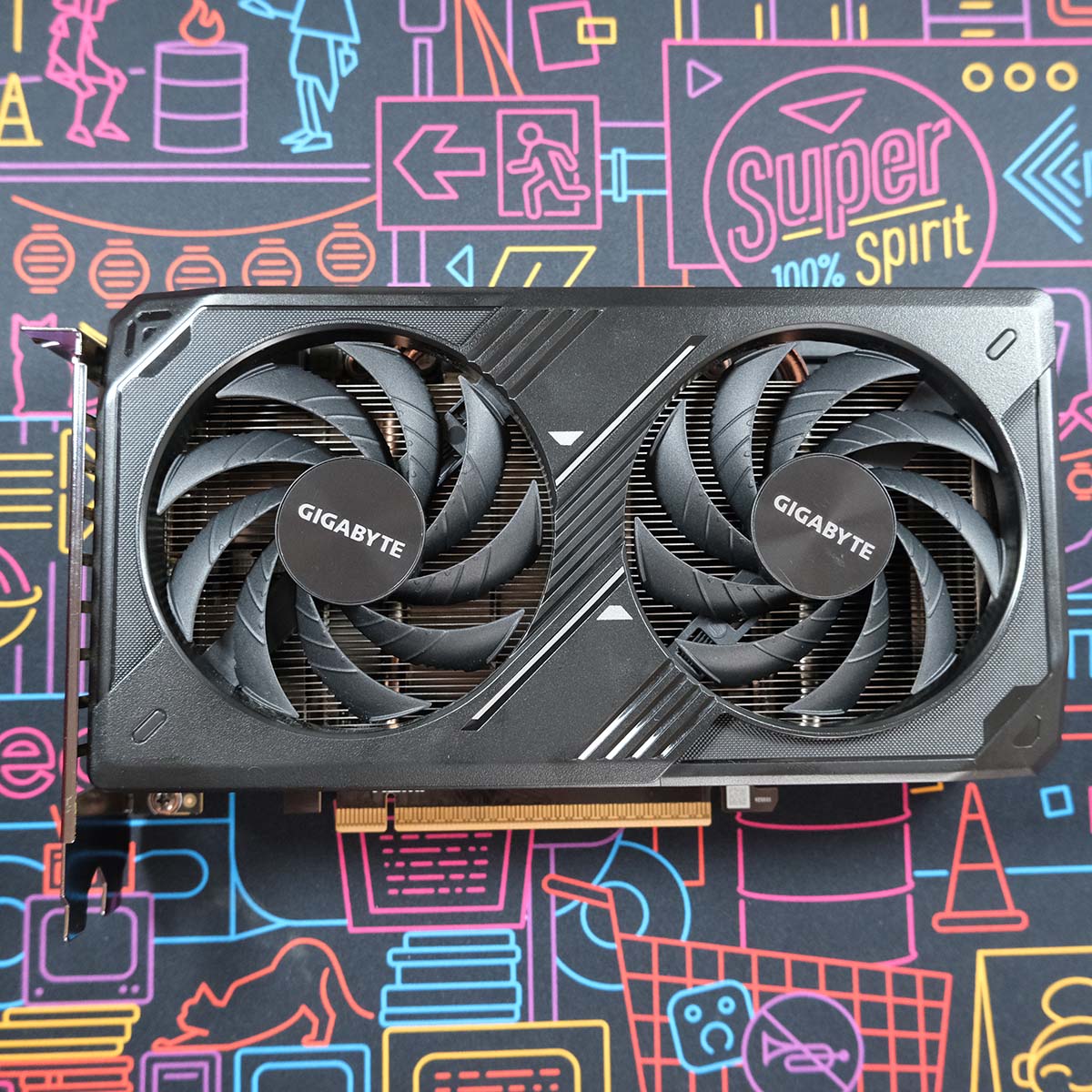
Windforce OC is on the smaller side, measuring in at 199 x 116 x 40mm and weighing a mere 500g. The compact cooler features two ‘Hawk’ fans whose blade designs take inspiration from an entirely different bird of prey, an eagle. Gigabyte claims these blowers deliver 53.6% more air pressure and 12.5% greater air volume than standard fans.
There’s no RGB to speak of, with Gigabyte instead opting for a black shroud with metallic accents. It’s a minimal but clean look that will fit nicely into practically any build.
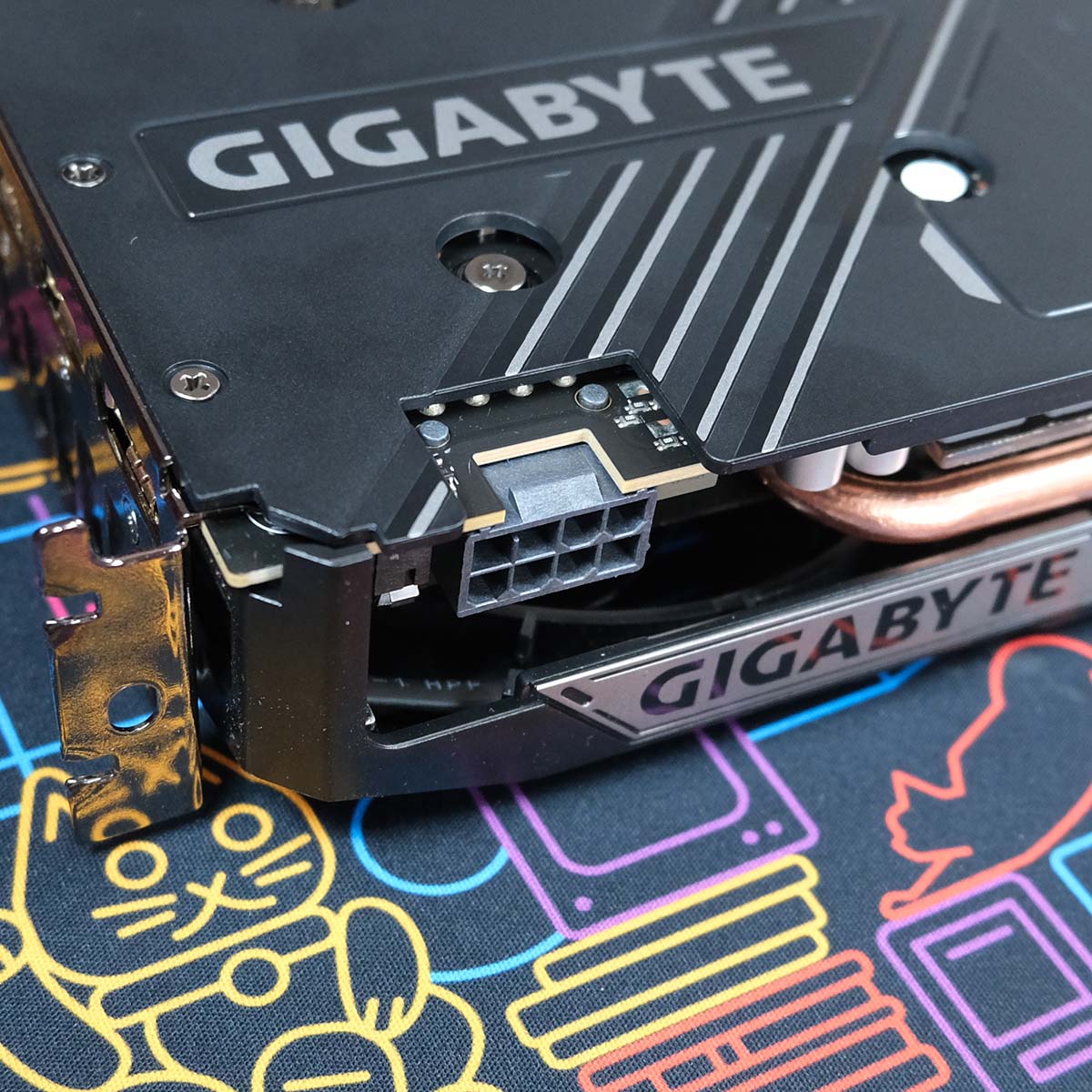
Curiously, Gigabyte places the 8-pin power connector towards the rear of the card rather than the middle. This required a little bit of tugging on wires for my PSU cables to reach and I doubt I’ll be alone in that regard.
Round back, you’ll find an assortment of HDMI 2.1 and DisplayPort 2.1b outputs. There’s two of each connector for you to connect Windforce OC to multiple displays, with DisplayPort providing the greatest amount of bandwidth.
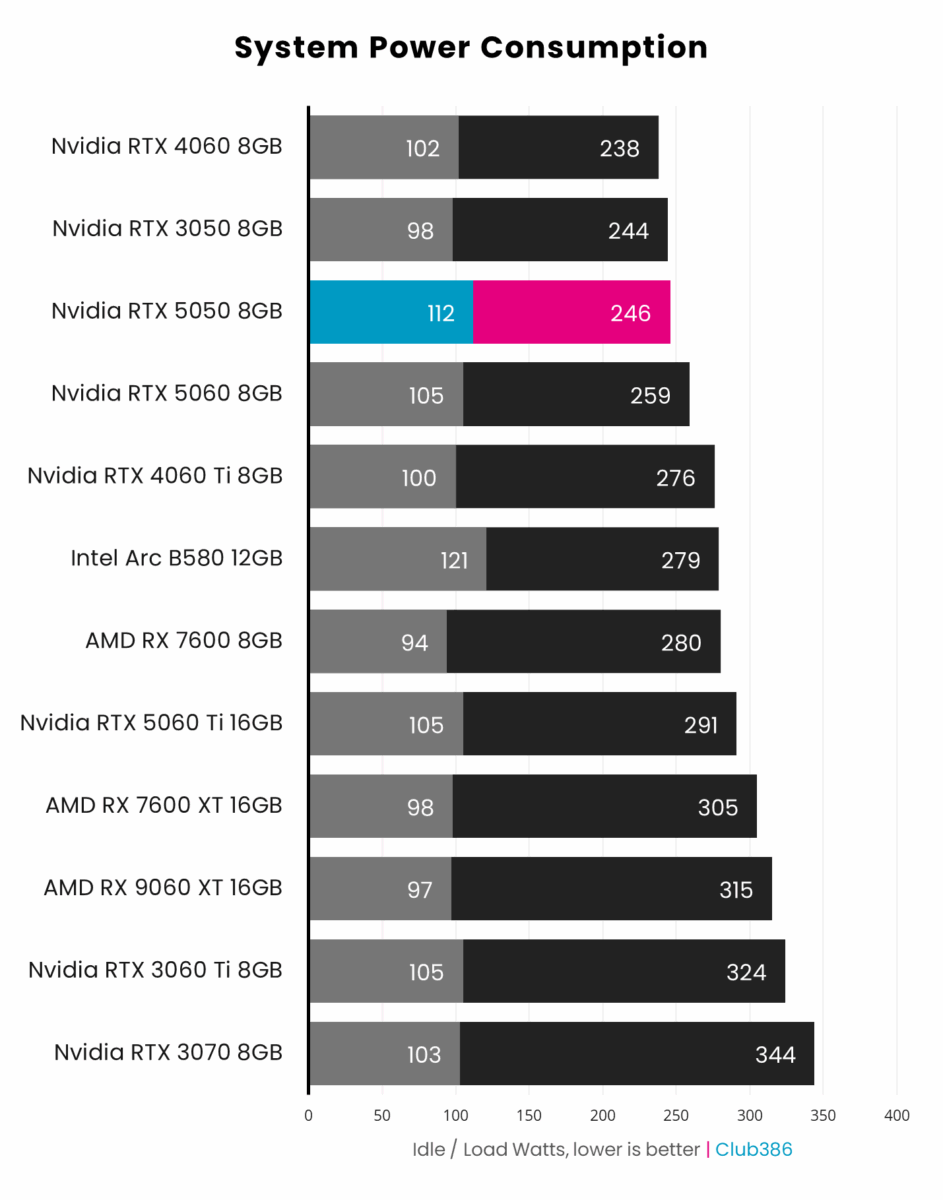
With Windforce OC in situ, system-wide power measured 112W while idle. This is slightly above the usual 105W ceiling that RTX 5060 and RTX 5060 Ti established previously but certainly not so high as to raise alarm bells. More importantly, power consumption under load is nice and frugal at 246W.
Speaking to other vitals, Windforce OC kept to a reasonable noise level of 35.5dbA under pressure. Curiously, though, the card was surprisingly hot at 75°C. Admittedly this was in the face of another 30+°C UK heatwave, so think of these values as a worst-case scenario.
Performance
Seating RTX 5050 into the Club386 Ryzen 9 7950X3D test bench may seem overkill. However, the breathing room this system provides only serves to paint the graphics card in its best light, free of bottlenecks.
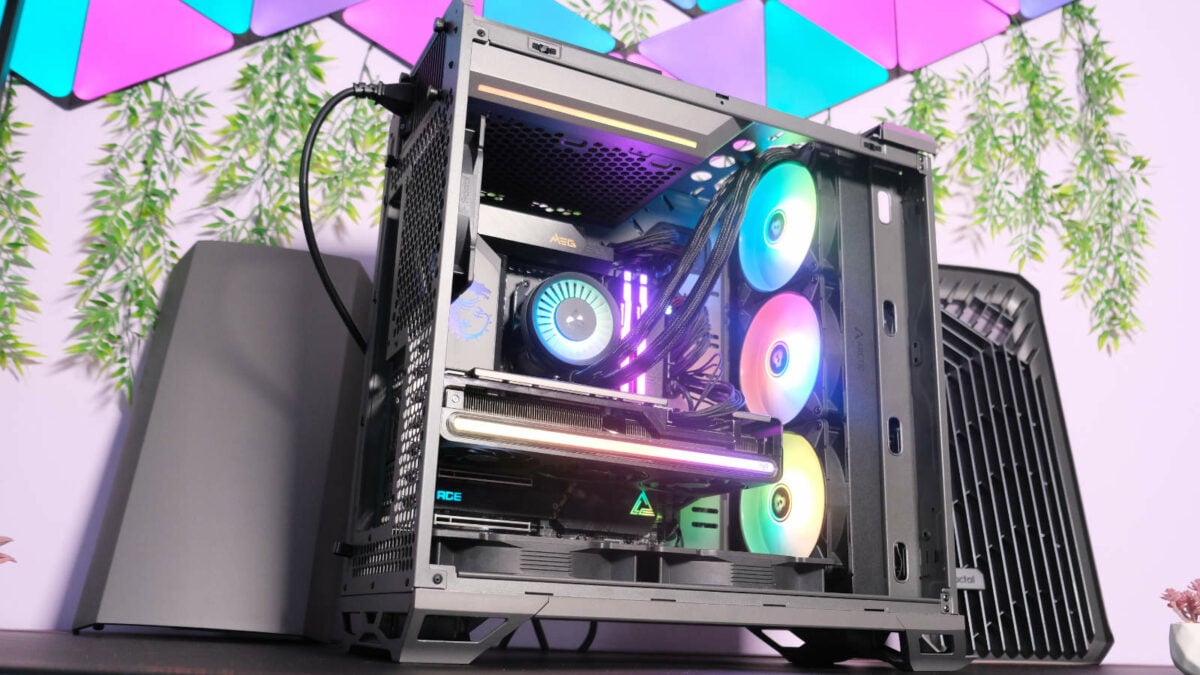
Our 7950X3D Test PCs
Club386 carefully chooses each component in a test bench to best suit the review at hand. When you view our benchmarks, you’re not just getting an opinion, but the results of rigorous testing carried out using hardware we trust.
Shop Club386 test platform components:
CPU: AMD Ryzen 9 7950X3D
Motherboard: MSI MEG X670E ACE
Cooler: Arctic Liquid Freezer III 420 A-RGB
GPU: Sapphire Nitro+ Radeon RX 7800 XT
Memory: 64GB Kingston Fury Beast DDR5
Storage: 2TB WD_Black SN850X NVMe SSD
PSU: be quiet! Dark Power Pro 13 1,300W
Chassis: Fractal Design Torrent Grey
Make no mistake, there’s little sense in venturing past 1080p with RTX 5050 in most circumstances given the limitations of its specifications. I’ve kept in-game benchmarks strictly limited to this resolution for that reason.
Apps & AI
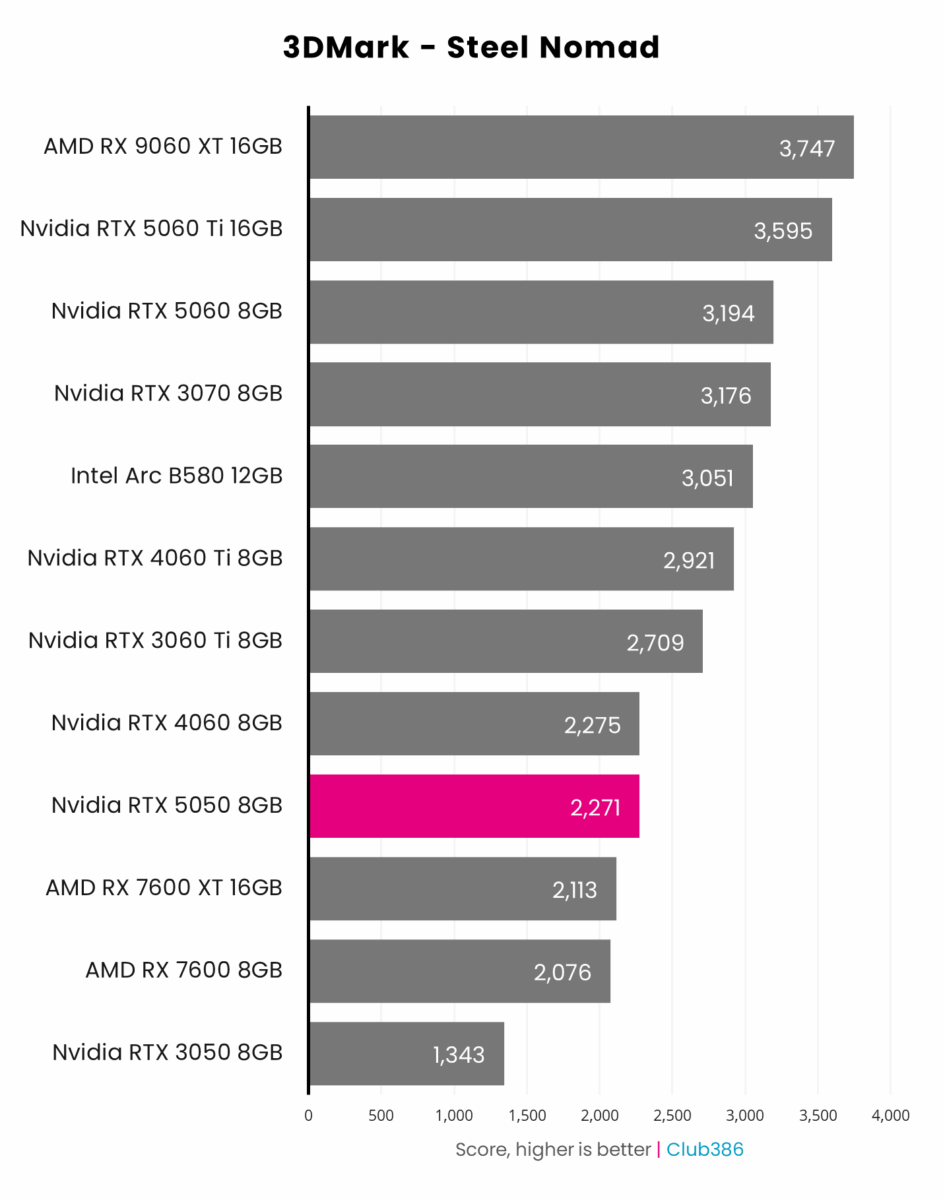
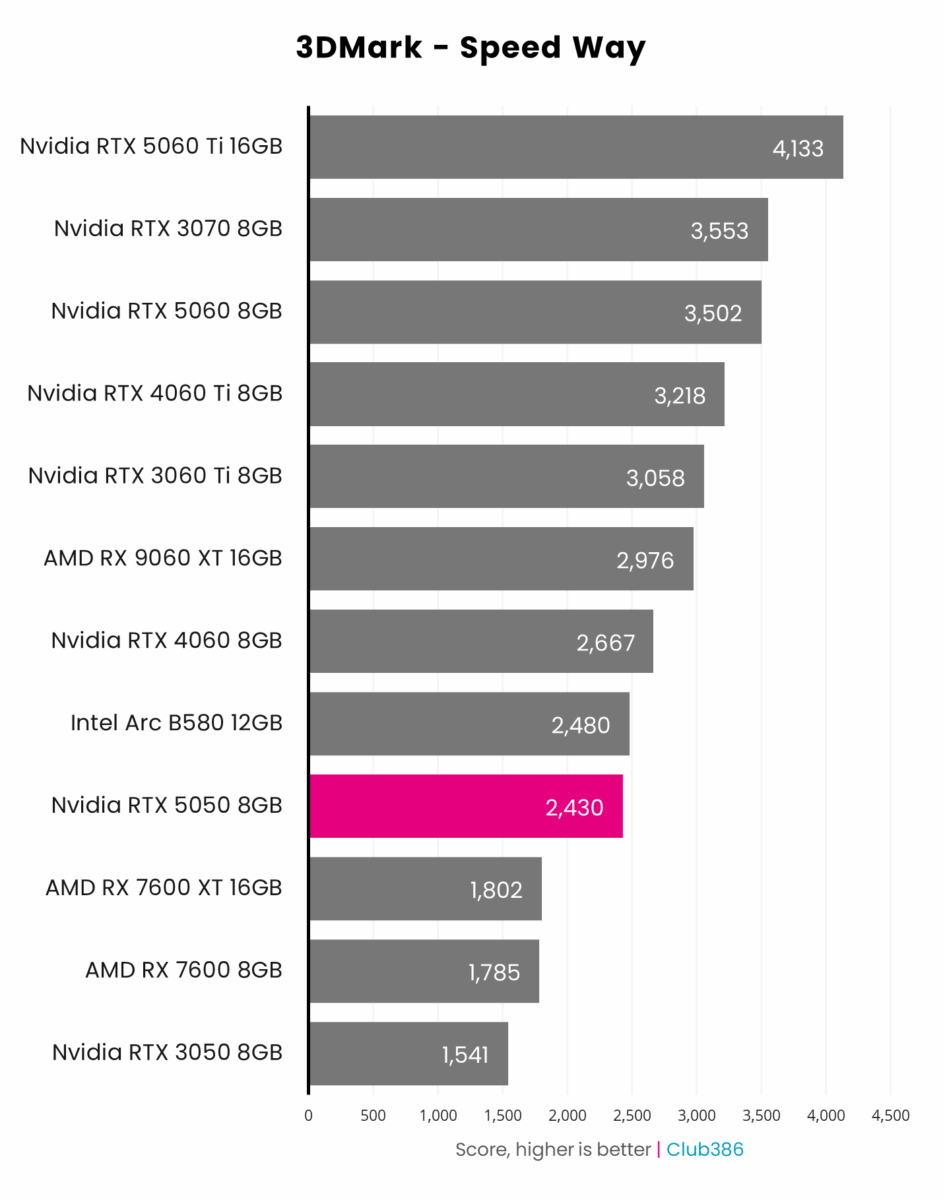
Synthetic 3DMark tests are always a good place to start, and interesting insofar as Steel Nomad and Speed Way run at internal resolutions of 3840×2160 and 2560×1440, respectively. More memory makes the rival Intel Arc stand out in the former, while the latter puts the competing duo neck and neck.
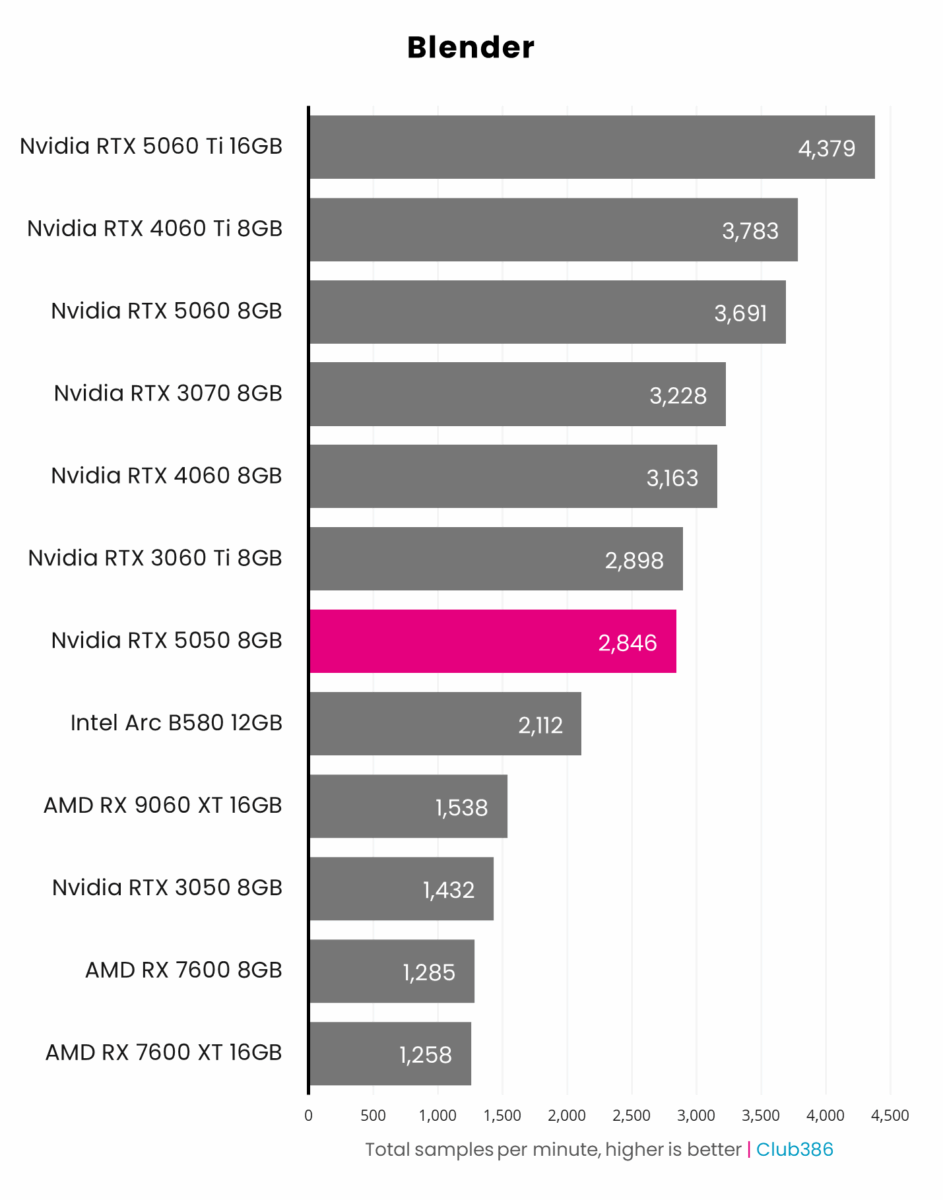
When it comes to Blender, RTX 5050 sees Nvidia enjoy continued dominance in the application. The card’s 2,846 samples per minute are almost double that of RX 9060 XT 16GB (1,538) as well as RTX 3050 (1,432), and a healthy ways ahead of Arc B580 (2,112).
Familial comparisons see RTX 5050 sit alongside RTX 3060 Ti and a few steps behind RTX 4060. Meanwhile, RTX 5060 zooms ahead with a 30% performance advantage at a 20% premium.
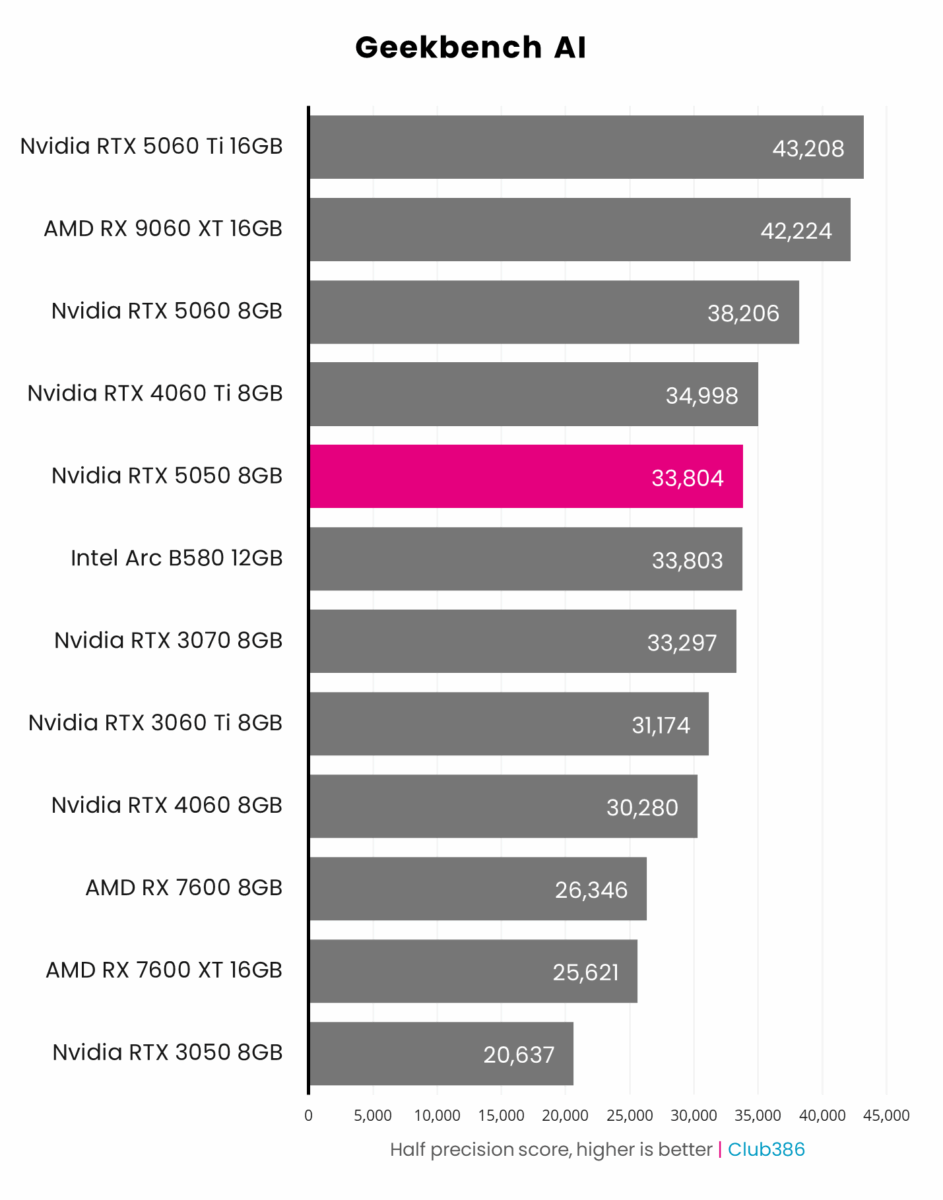
In a surprise turn of events, RTX 5050 actually clips past Arc B580 in Geekbench AI’s half precision benchmark. Though the card’s victory lies within margin of error, defined by a single point advantage (33,804 vs. 33,803), it remains a win nonetheless. Still, it’s not a result I expected given the advantage Intel’s contender card enjoys in terms of theoretical FP16 performance, at least on paper.
Looking more broadly across the chart, RTX 5050 does well to hold its own. RTX 5060 claims a meagre 13% lead, and RTX 4060 Ti 8GB is the only prior generation card to surpass the new pixel pusher, and by 4% at that. Generational improvements aren’t disappointing either, with a score 64% the better of RTX 3050.
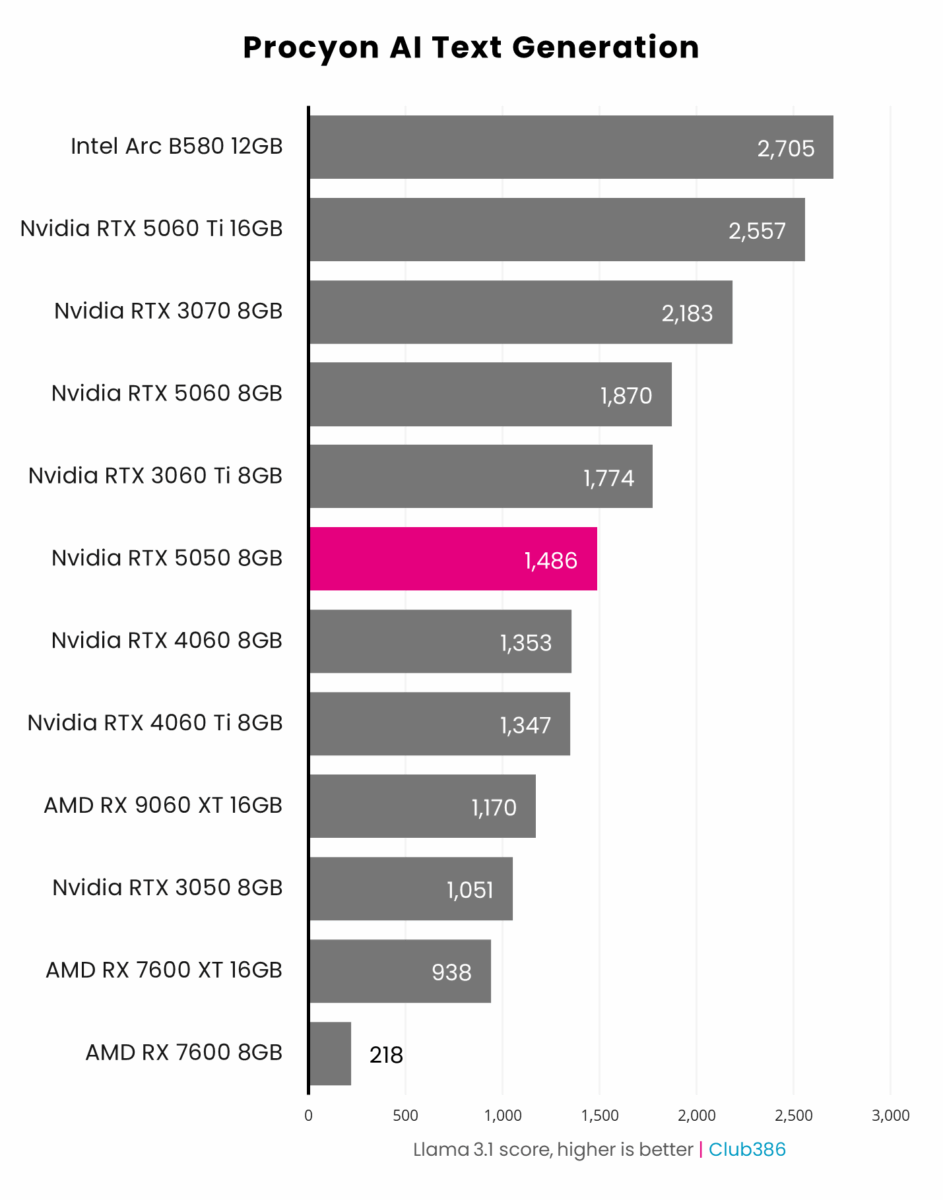
In Procyon’s Llama 3.1 benchmark, RTX 5050 delivers a welcome 41% generational improvement and dunks on any Radeon that dare rival it. However, the card doesn’t hold a candle to Arc B580, which emerges the overall victor on the chart, surpassing even RTX 5060 Ti 16GB.
While this LLM (Large Language Model) clearly has an affinity for Intel’s Battlemage architecture, memory bandwidth and capacity undoubtedly play their parts. RTX 5050 is weaker in both regards, leaving the card well behind its blue competitor in memory-intensive workloads.
Gaming
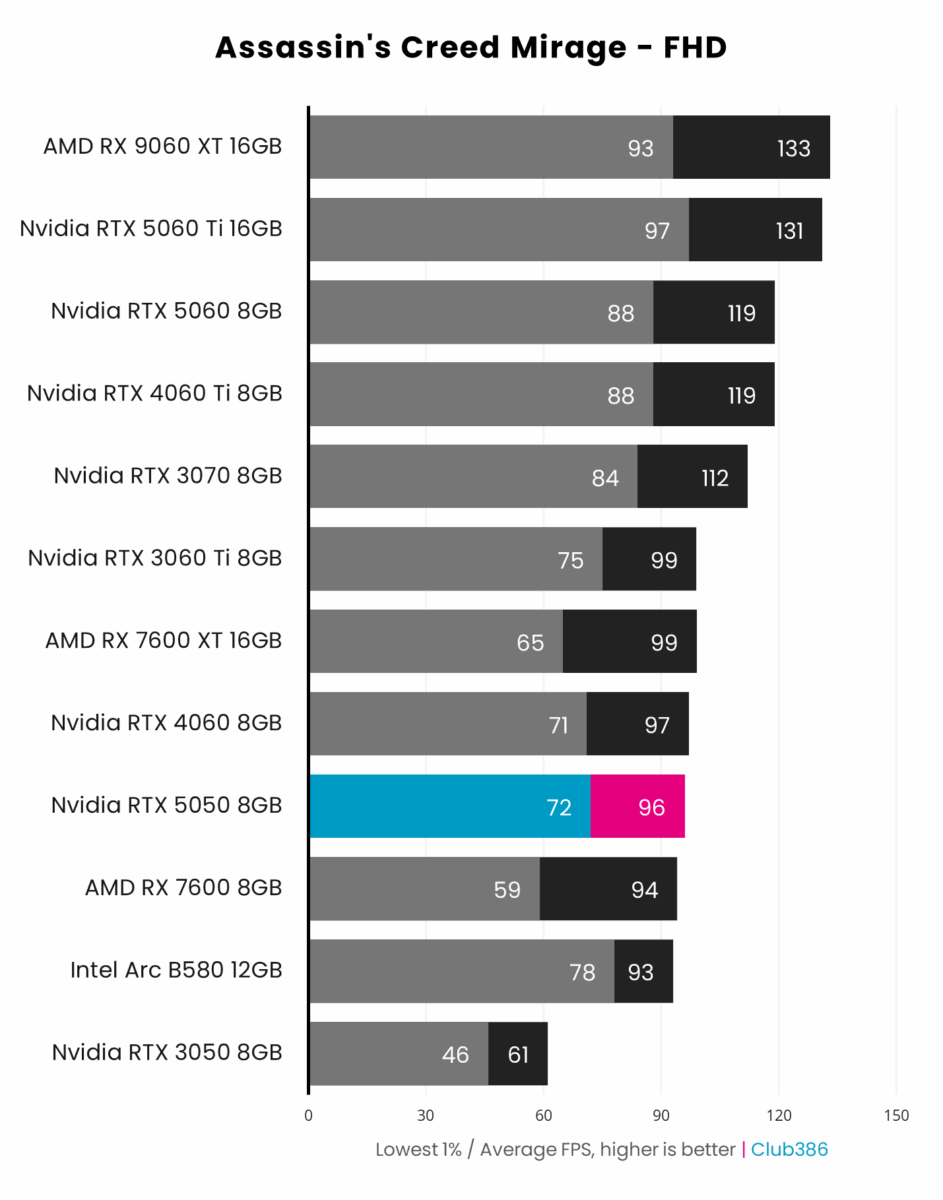
Running Assassin’s Creed Mirage at the game’s highest settings at 1080p requires around 6GB of VRAM, allowing RTX 5050 to gracefully sprint through the benchmark with nary a stumble. An average frame rate of 96fps and respectable minimums of 72fps create an appreciably smooth gameplay experience.
Like in 3DMark Steel Nomad, RTX 5050 rasterised performance here is almost identical to RTX 4060 (97fps). Arc B580 (93fps) is only a few frames behind and does offer a slightly more consistent frame rate with a 78fps minimum. The real loser here is RX 7600 (94fps), whose woefully low minimum performance of 59fps spoils its average.
Stretching to RTX 5060 does provide slightly better value, with a cost-per-frame of $2.52 versus RTX 5050’s $2.60. However, if you’re ready to move away from the likes of RTX 3050 while keeping costs down to a minimum, RTX 5050 delivers desired minimums of over 60fps.
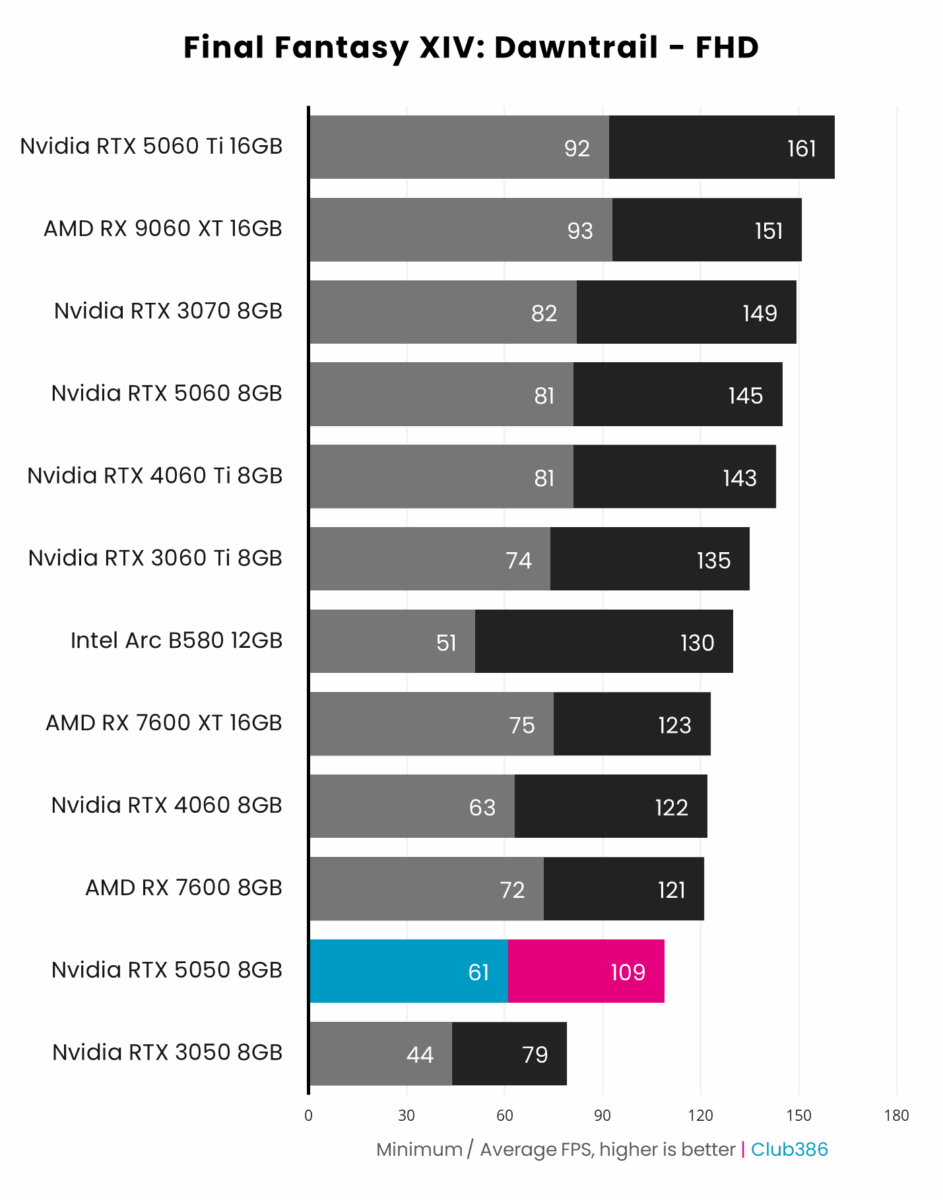
Final Fantasy XIV: Dawntrail proves difficult for RTX 5050, falling behind all rivals and peers save for its predecessor. The performance uplift from RTX 3050 is a welcome 38%, but it’s not enough to keep pace with more contemporary competition.
Besting RTX 5050’s 109fps average, Arc B580 musters a healthier 130fps albeit with an oddly low minimum frame rate of 51fps. Meanwhile, both RTX 4060 and RX 7600 cruise along at a slightly more comfortable 121-122fps.
Looking up the chain, RTX 5060 once again is providing stronger value at $2.07 per frame to RTX 5050’s $2.29. VRAM isn’t a limiting factor here, meaning RX 9060 XT 8GB may also emerge as a solid value buy. However, it’s Arc B580 that takes the crown in our tests, impressively pushing cost per frame to $1.92.
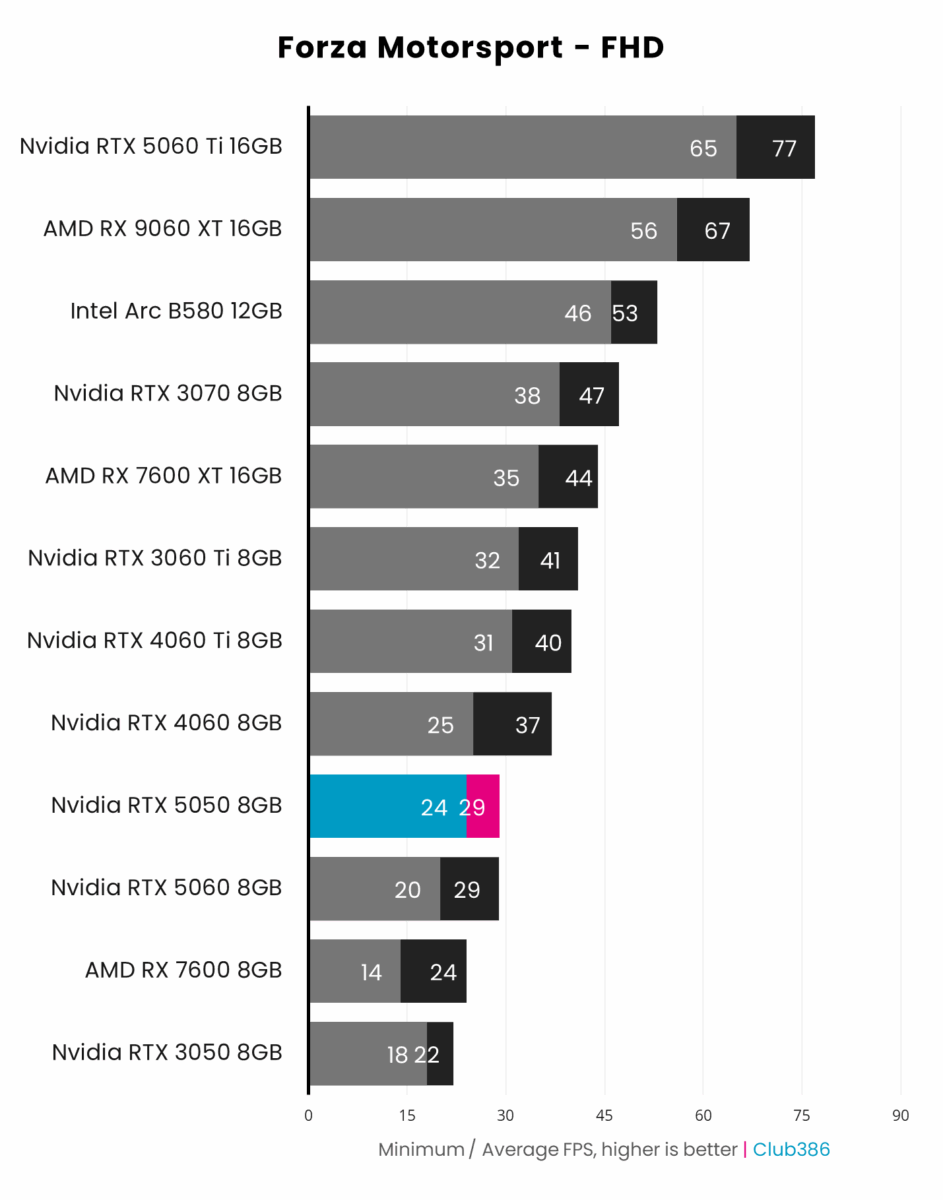
Racing in Forza Motorsport at maximum settings with just 8GB of VRAM is like driving on tyres with little tread: doable in a pinch but you’re liable to lose your grip. The game explicitly warns against hitting the tarmac with such demanding graphics and the frame rates above clearly demonstrate why.
This VRAM bottleneck is so great that RTX 5050 and RTX 5060 find themselves side-by-side, sputtering along with an average frame rate of 29fps. Meanwhile, Arc B580 more confidently grips the road with 12GB of memory under the hood, crossing the finish line with a 53fps average.
To be clear, this is a nightmare scenario for RTX 5050 and its 8GB ilk but illustrates the limitations of their relatively small buffer. Just look at how differently RX 7600 and RX 7600 XT perform, practically identical GPUs with VRAM serving as the only meaningful delta. In demanding titles such as this, RTX 5050 users will inevitably need to dial-down quality settings to achieve the desired results.
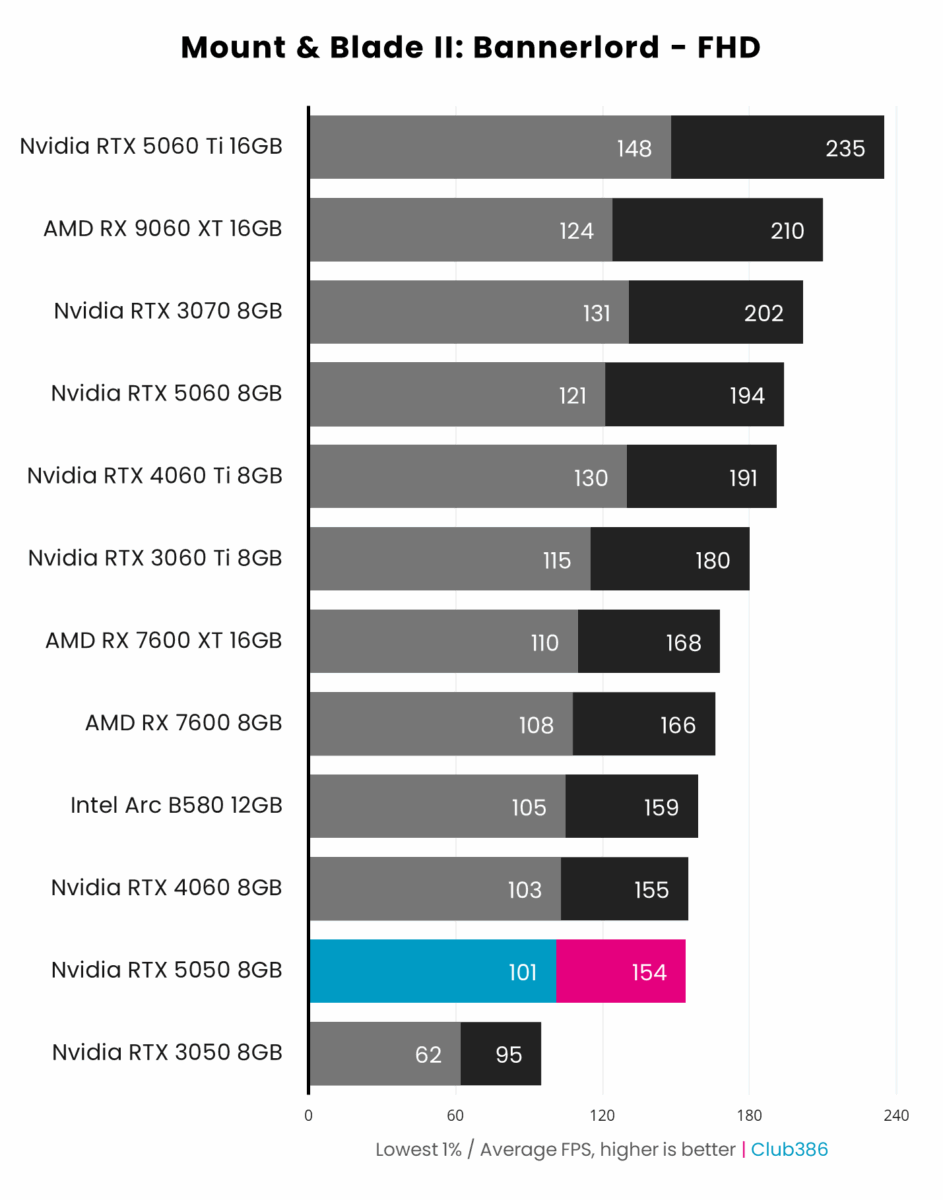
Freed from any proverbial VRAM vices, RTX 5050 takes the war-torn plains of Mount & Blade II: Bannerlord with grace. Though it’s difficult to sniff at a 154fps average, performance is behind Arc B580’s 159fps, while RX 7600 and RX 7600 XT prove the smoothest swordsmen with respective frame rates of 166fps and 168fps.
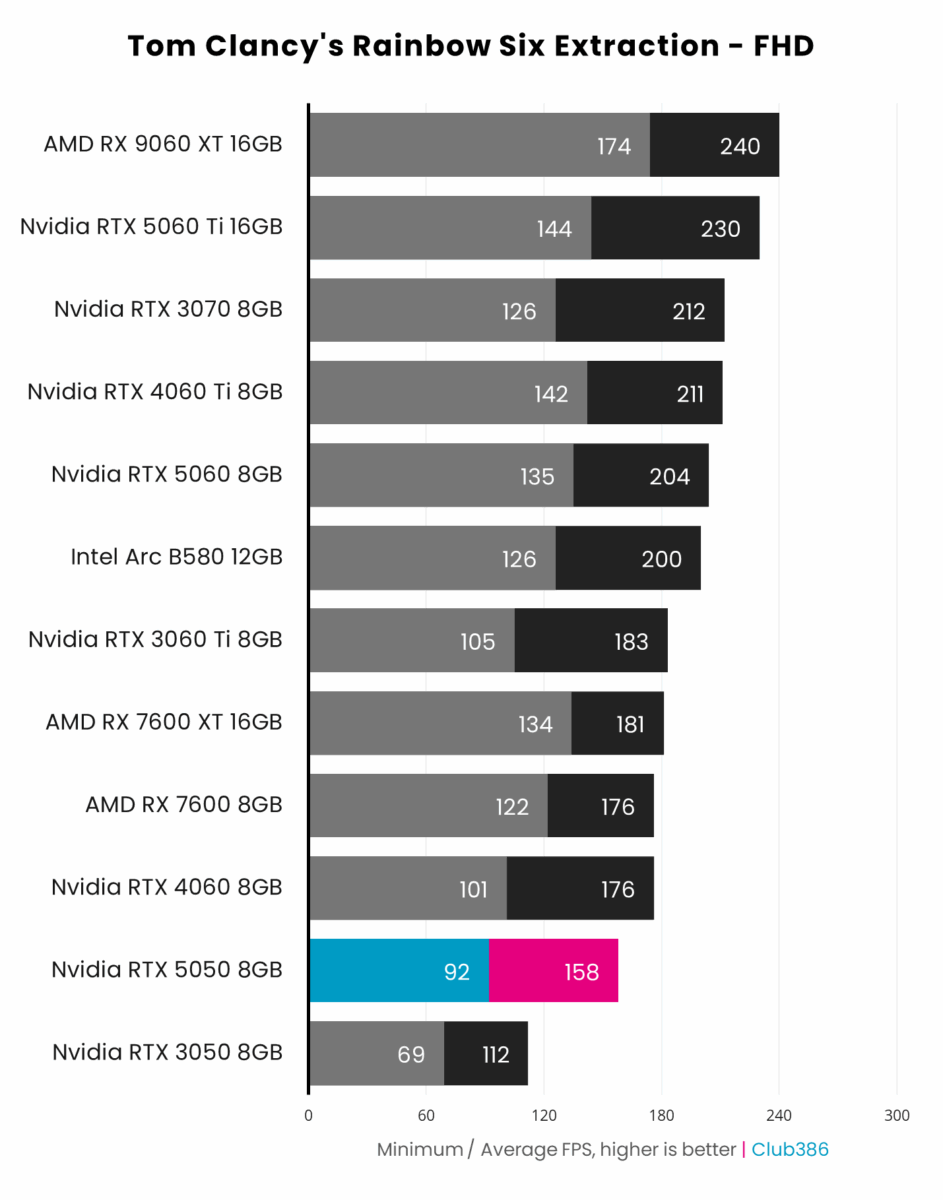
Firing off 158fps on average in Rainbow Six Extraction paints RTX 5050 as a competent if not particularly exciting candidate for an esports system. As much as Nvidia Reflex helps sweeten the value this card would offer such a machine, it’s difficult to ignore the additional frames alternatives provide.
Arc B580 pushes performance to another level, hitting 200fps, coming within spitting distance of the 204fps that RTX 5060 delivers. That’s a 27% increase in frame rate at the same price point.
One caveat, of course, is brand maturity. Though Arc drivers and features have come a long way, GeForce has a head start and then some. It’s a question of whether you value raw performance over feature set.
| To RTX 5050 8GB | Relative Avg. Perf. | Relative Avg. Perf. (minus Forza) |
|---|---|---|
| From RTX 3050 8GB | +31% | +33% |
| From RX 7600 8GB | -2% | -7% |
| From RX 4060 8GB | -11% | -6% |
| From RX 7600 XT 16GB | -18% | -10% |
| From RTX 3060 Ti 8GB | -20% | -15% |
| From RTX 5060 8GB | -22% | -28% |
| From Arc B580 12GB | -26% | -11% |
| From RTX 4060 Ti 8GB | -30% | -28% |
| From RTX 3070 8GB | -36% | -30% |
| From RX 9060 XT 16GB | -59% | -41% |
| From RTX 5060 Ti 16GB | -70% | -46% |
In the table above I’ve averaged the difference in performance between RTX 5050 and the other graphics cards in the chart. Unfortunately, the card doesn’t manifest a significant lead over Arc B580, even after removing Forza Motorsport from the pool of results and thereby removing Intel’s VRAM advantage.
RTX 5050 also fails to materialise compelling value over both RTX 5060 and RX 9060 XT 8GB. Both of these cards carry a 20% higher cost but provide 28-41% better performance, parsing results sans Forza Motorsport. Graphics cards should boast better value the further down the stack they fall, not the other way around.
Through RTX 5050, we’re essentially staring down the barrel of RX 7600 performance with superior ray tracing. Of course, these percentages don’t illustrate the benefits of the card’s stronger feature set through DLSS 4. Speaking of…
DLSS 4
As part of the RTX 50 Series family, RTX 5050 has access to the entire DLSS 4 suite. This includes DLSS Super Resolution as well as Single and Multi Frame Generation. Perhaps most compellingly, the card can use Nvidia’s Transformer model for upscaling with no performance penalty, unlike prior generation models.
DLSS 4 can prove transformative in the right scenario, boosting frame rates through upscaling and improving motion clarity through frame generation. While there are no performance requirements for DLSS Super Resolution, getting the most benefit from Frame Generation comes with the prerequisite of a 60fps frame rate.
Providing you can fulfil that criteria, DLSS 4 offers best-in-class upscaling and frame generation. However, hitting that 60fps baseline for frame gen on RTX 5050 is naturally trickier than more-powerful cards. These limitations are important to bear in mind, as ignoring them can have disastrous consequences to performance.
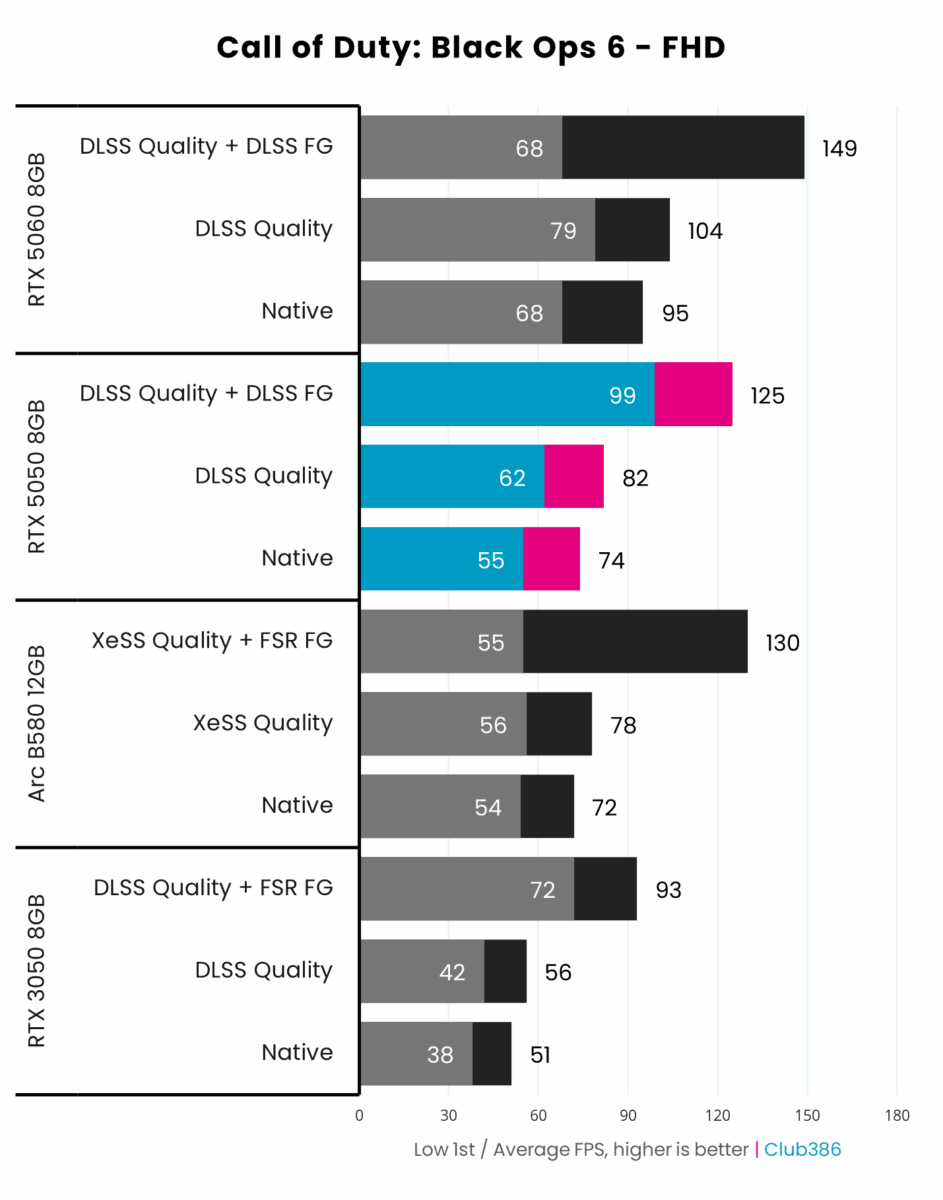
Dropping into Call of Duty: Black Ops 6, RTX 5050 makes short work of Activision’s FPS without any assistance from performance enhancers. Building on a 72fps average, DLSS Super Resolution pushes performance up to 82fps with minimum frame rates also getting a welcome boost. With a rock-solid baseline established, DLSS Super Resolution and Frame Generation combine and help the card enter triple-digit territory and output 125fps on average.
RTX 5060 is 27-28% ahead of RTX 5050 before DLSS Frame Generation comes into play, where its lead shrinks to 19%. Meanwhile, Arc B580 nips at the heels of its identically-priced rival, only able to pull ahead through the application of FSR Frame Generation. However, those generated frames will be of a noticeably lesser quality, making Intel’s victory of 5fps ultimately moot.
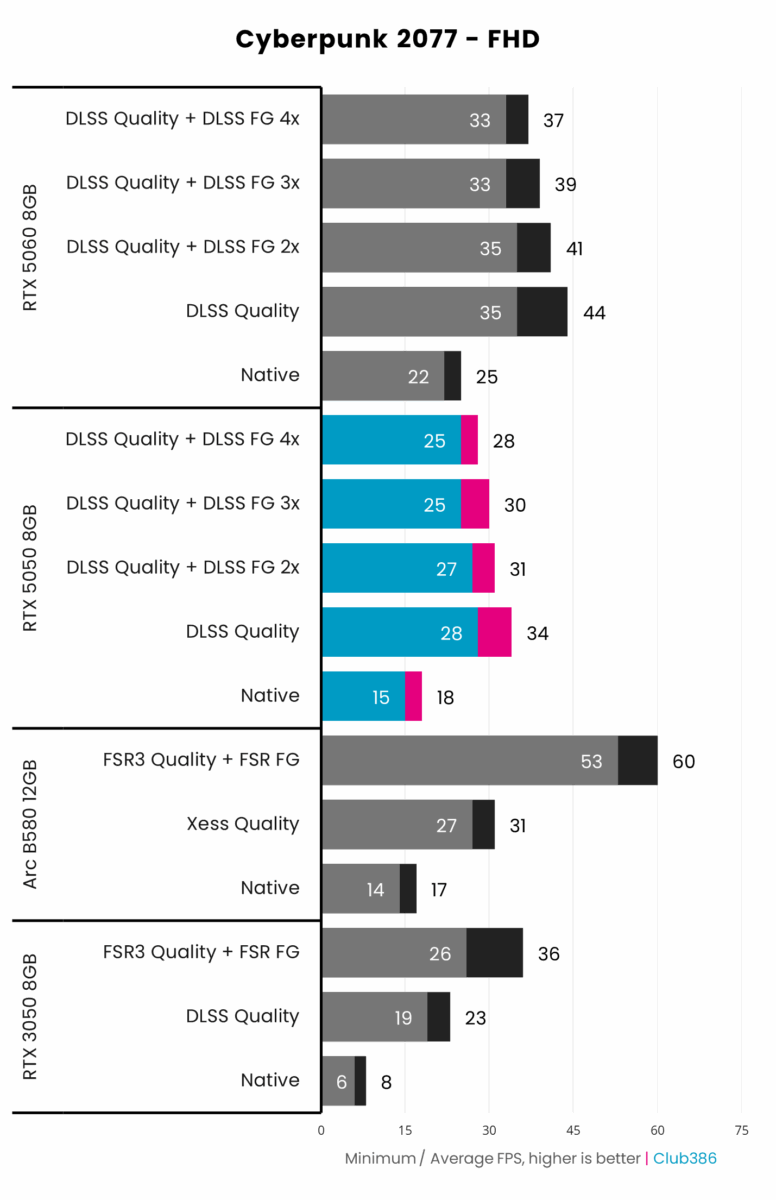
Cyberpunk 2077 with path tracing is the ultimate challenge for any graphics card, budget or flagship. While RTX 5050 expectedly produces a slideshow at native 1080p, the card impressively pushes beyond 30fps with DLSS enabled. While 60fps remains my preferred frame rate threshold, I can’t help but admire a budget offering producing a playable experience in the face of a demanding workload.
It’s possible to enable frame generation at this point but doing so isn’t advisable. Not only is the baseline frame rate too low to keep latency at bay, but the feature actually causes performance to regress. I observed the exact same behaviour on RTX 5060, and I’m confident that this is an issue stemming from VRAM and/or bandwidth limitations.
Arc B580 isn’t quite as fast as RTX 5050 using XeSS upscaling in place of DLSS Super Resolution, but only by 3fps. Unfortunately, CD Projekt Red hasn’t implemented XeSS-FG into Cyberpunk 2077, so the card must fall back to FSR 3. This results in higher performance but both image quality and latency are poor to the point of ridding the option of worth.
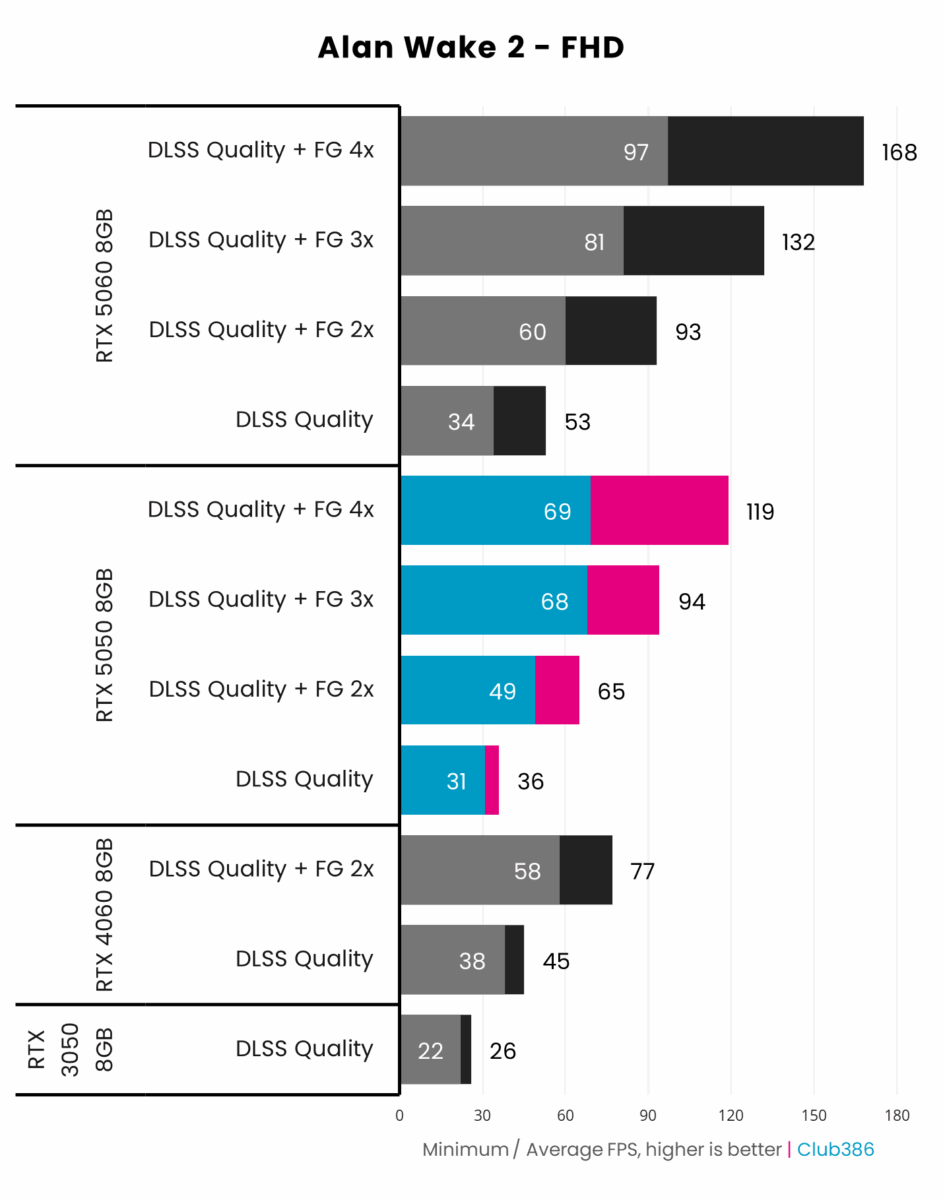
It’s impossible to run Alan Wake 2 on the same settings across Arc, Radeon, and GeForce, as path tracing options are only open to Nvidia’s GPUs. With this in mind, I’ve subbed out Arc B580 for RTX 4060 as a point of comparison.
There’s no native performance to digest as Alan Wake 2 requires the use of DLSS or FSR 2. Regardless, RTX 5050 keeps its head above water with an average frame rate of 36fps.
Again, this doesn’t meet the 60fps threshold required for an ideal experience using frame generation. However, settling for less intense settings should steer performance in the right direction. Personally, though, I’d settle for a 30fps experience with all the pretty path traced bells and whistles.
| Avg. Latency | |
|---|---|
| DLSS | 81.0ms |
| DLSS+FG | 91.3ms |
| DLSS+FG 3x | 95.7ms |
| DLSS+FG 4x | 102.5ms |
Latency in Alan Wake 2 on RTX 5050 using these settings is expectedly high. As someone that’s particularly sensitive to latency, 81ms is about the limit of what I can tolerate. While enabling frame generation makes the game look smoother, it only serves to make it feel worse.
For context, RTX 5060 feels far more playable with a latency range of 54.3-73.0ms. This is because the base average frame rate from which DLSS Frame Generation is working from is much higher, namely 53fps to RTX 5050’s 34fps.
I’m highlighting these values not to dissuade you from using DLSS Frame Generation on RTX 5050, but instead to caution you on the consequences of improper application. As I said in the beginning of this section, DLSS 4 can be transformative but it requires some work to use appropriately, especially so on a budget graphics card like this.
Conclusion
RTX 5050 holds its own when it comes to AI and other categories, including impressively low power consumption. DLSS 4 helps sweeten solid gaming performance but it’s difficult to ignore the frequently higher base frame rates of Arc B580.
Unfortunately for Intel, the brand is yet to bring issues surrounding Arc B580 availability under control. Lack of stock continues to push the price of what units are available up to untenable levels. This situation should prove temporary but there’s no sign of a resolution approaching anytime soon.
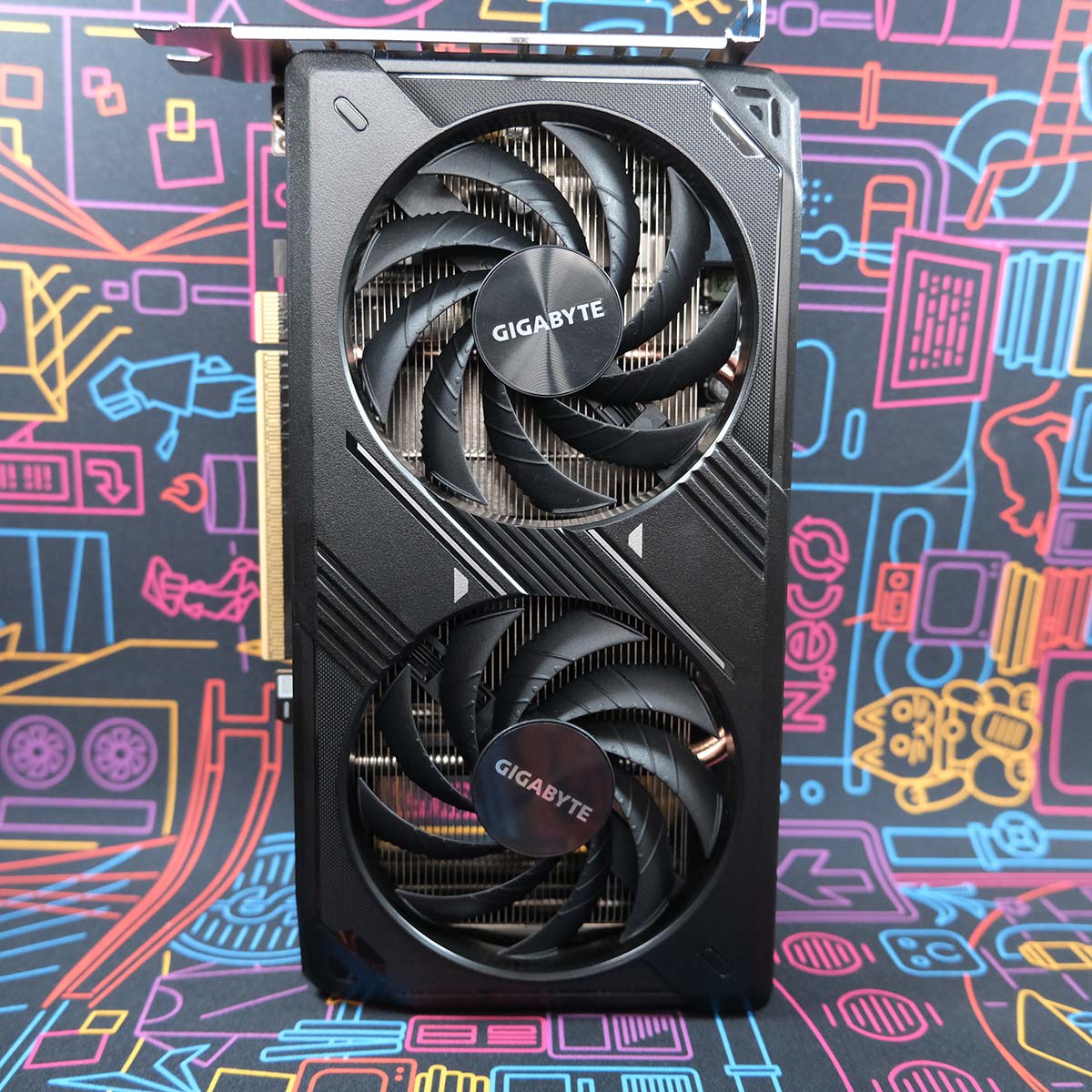
This leaves RTX 5050 unchallenged in the retail space at $250. There are second-hand options available for slightly less, but none are substantially cheaper to the point of providing a compelling alternative. That’s not forgetting that you’d forgo warranties or the ability to run the Transformer model for DLSS without any penalty.
If you can stretch your budget to $300, I’d strongly suggest picking up RTX 5060 or RX 9060 XT 8GB instead. While neither address the same VRAM concerns I have with RTX 5050, they do provide greater bang for your buck.
For those in immediate need of a new graphics card with no greater than $250 to spend, RTX 5050 is your only viable choice. This new addition to the Blackwell family certainly won’t set the world alight, but it fills a corner of the market that’s otherwise starving.


